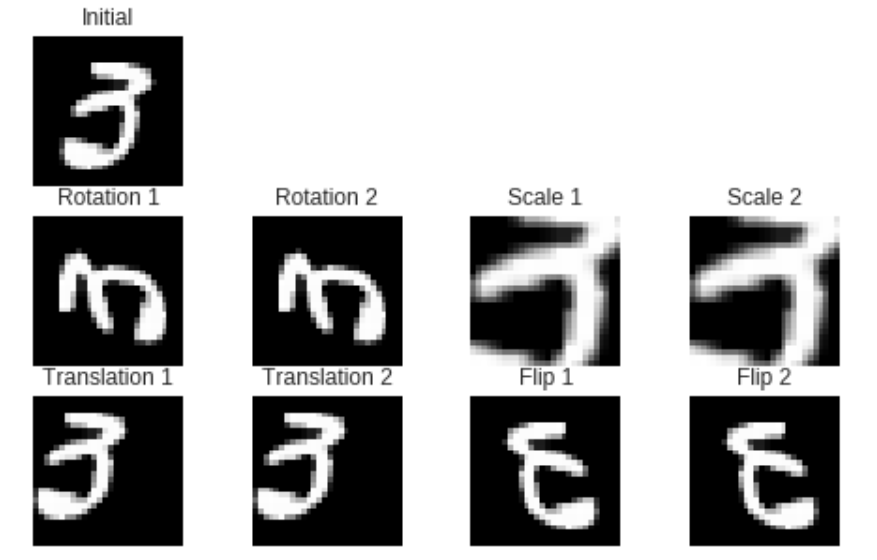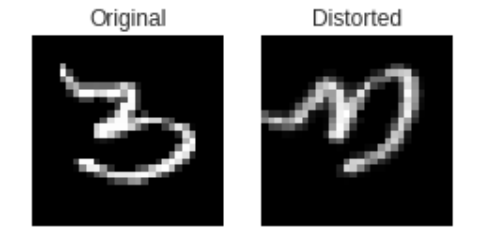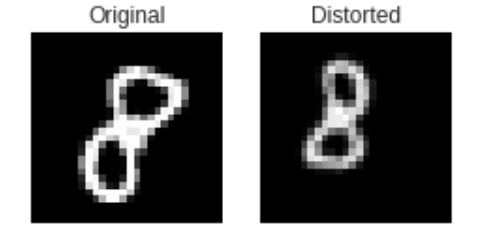ポイント
- skimage.transform を用いて、distorted MNIST を作成。
- 今後、distorted MNIST を使用し、モデルのパフォーマンス検証を実施。
レファレンス
データ
MNIST handwritten digits
###
from tensorflow.examples.tutorials.mnist import input_data
mnist = input_data.read_data_sets('***/mnist', \
one_hot = True)
###
from sklearn import datasets
mnist = datasets.fetch_mldata('MNIST original')
images, targets = mnist.data, mnist.target
images = images / 255.0
n = len(images)
s = np.random.permutation(n)
nn = int(n / 5)
images_train, images_test = images[s[nn:]], images[s[:nn]]
targets_train, targets_test = targets[s[nn:]], targets[s[:nn]]
サンプルコード1
import skimage.transform
# initial
index = np.random.randint(1000)
image_initial = np.reshape(mnist.train.images[index], \
[28, 28])
# rotation
angle = 90
theta = 1.0 * angle / 180 * np.pi
matrix_r = np.array([[np.cos(theta), -np.sin(theta), \
14 * (1 + np.sin(theta) - np.cos(theta))], \
[np.sin(theta), np.cos(theta), \
14 * (1 - np.sin(theta) - np.cos(theta))], \
[0, 0, 1]])
tform_r_1 = skimage.transform.AffineTransform(matrix = \
matrix_r)
image_r_1 = skimage.transform.warp(image_initial, tform_r_1)
src_r = np.array([[21, 7], [21, 21], [7, 21], [7, 7]])
dst_r = np.array([[7, 7], [21, 7], [21, 21], [7, 21]])
tform_r_2 = skimage.transform.ProjectiveTransform()
tform_r_2.estimate(dst_r, src_r)
image_r_2 = skimage.transform.warp(image_initial, tform_r_2)
# scale
scale = 2
s = 1.0 / scale
matrix_s = np.array([[s, 0, -14 * (s - 1)],
[0, s, -14 * (s - 1)],
[0, 0, 1]])
tform_s_1 = skimage.transform.AffineTransform(matrix = \
matrix_s)
image_s_1 = skimage.transform.warp(image_initial, tform_s_1)
src_s = np.array([[10.5, 10.5], [17.5, 10.5], \
[17.5, 17.5], [10.5, 17.5]])
dst_s = np.array([[7, 7], [21, 7], [21, 21], [7, 21]])
tform_s_2 = skimage.transform.ProjectiveTransform()
tform_s_2.estimate(dst_s, src_s)
image_s_2 = skimage.transform.warp(image_initial, tform_s_2)
# translation
t_x = 5
t_y = 2
matrix_t = np.array([[1, 0, t_x],
[0, 1, t_y],
[0, 0, 1]])
tform_t_1 = skimage.transform.AffineTransform(matrix = \
matrix_t)
image_t_1 = skimage.transform.warp(image_initial, tform_t_1)
src_t = np.array([[7 + t_x, 7 + t_y], [21 + t_x, 7 + t_y], \
[21 + t_x, 21 + t_y], [7 + t_x, 21 + t_y]])
dst_t = np.array([[7, 7], [21, 7], [21, 21], [7, 21]])
tform_t_2 = skimage.transform.ProjectiveTransform()
tform_t_2.estimate(dst_t, src_t)
image_t_2 = skimage.transform.warp(image_initial, tform_t_2)
# flip
matrix_f = np.array([[-1, 0, 28],
[0, 1, 0],
[0, 0, 1]])
tform_f_1 = skimage.transform.AffineTransform(matrix = \
matrix_f)
image_f_1 = skimage.transform.warp(image_initial, tform_f_1)
src_f = np.array([[21, 7], [7, 7], [7, 21], [21, 21]])
dst_f = np.array([[7, 7], [21, 7], [21, 21], [7, 21]])
tform_f_2 = skimage.transform.ProjectiveTransform()
tform_f_2.estimate(dst_f, src_f)
image_f_2 = skimage.transform.warp(image_initial, tform_f_2)
fig = plt.figure(figsize = (8, 5))
ax = fig.add_subplot(3, 4, 1)
ax.imshow(image_initial, cmap = 'gray')
ax.set_title('Initial')
ax.set_axis_off()
ax_r_1 = fig.add_subplot(3, 4, 5)
ax_r_1.imshow(image_r_1, cmap = 'gray')
ax_r_1.set_title('Rotation 1')
ax_r_1.set_axis_off()
ax_r_2 = fig.add_subplot(3, 4, 6)
ax_r_2.imshow(image_r_2, cmap = 'gray')
ax_r_2.set_title('Rotation 2')
ax_r_2.set_axis_off()
ax_s_1 = fig.add_subplot(3, 4, 7)
ax_s_1.imshow(image_s_1, cmap = 'gray')
ax_s_1.set_title('Scale 1')
ax_s_1.set_axis_off()
ax_s_2 = fig.add_subplot(3, 4, 8)
ax_s_2.imshow(image_s_2, cmap = 'gray')
ax_s_2.set_title('Scale 2')
ax_s_2.set_axis_off()
ax_t_1 = fig.add_subplot(3, 4, 9)
ax_t_1.imshow(image_t_1, cmap = 'gray')
ax_t_1.set_title('Translation 1')
ax_t_1.set_axis_off()
ax_t_2 = fig.add_subplot(3, 4, 10)
ax_t_2.imshow(image_t_2, cmap = 'gray')
ax_t_2.set_title('Translation 2')
ax_t_2.set_axis_off()
ax_f_1 = fig.add_subplot(3, 4, 11)
ax_f_1.imshow(image_f_1, cmap = 'gray')
ax_f_1.set_title('Flip 1')
ax_f_1.set_axis_off()
ax_f_2 = fig.add_subplot(3, 4, 12)
ax_f_2.imshow(image_f_2, cmap = 'gray')
ax_f_2.set_title('Flip 2')
ax_f_2.set_axis_off()
plt.show()
アウトプット1
サンプルコード2
import skimage.transform
def distorted_image_generator(original_images):
distorted_images = []
for i in range(len(original_images)):
image = np.reshape(original_images[i], [28, 28])
s = 1.0
if (np.random.uniform(low = 0.0, high = 1.0) < 0.5):
s = np.random.uniform(low = 1.0, high = 1.5)
angle = np.random.uniform(360.0)
tx = np.random.randint(5)
ty = np.random.randint(5)
# rotate
theta = 1.0 * angle / 180 * np.pi
matrix_r = np.array([[np.cos(theta), -np.sin(theta), \
14 * (1 + np.sin(theta) - np.cos(theta))], \
[np.sin(theta), np.cos(theta), 14 * (1 - \
np.sin(theta) - np.cos(theta))], [0, 0, 1]])
tform_r = skimage.transform.AffineTransform(matrix = \
matrix_r)
image_distorted = skimage.transform.warp(image, tform_r)
# scale
matrix_s = np.array([[s, 0, -14 * (s - 1)],
[0, s, -14 * (s - 1)],
[0, 0, 1]])
tform_s = skimage.transform.AffineTransform(matrix = \
matrix_s)
image_distorted = skimage.transform.warp( \
image_distorted, tform_s)
# translation
matrix_t = np.array([[1, 0, tx],
[0, 1, ty],
[0, 0, 1]])
tform_t = skimage.transform.AffineTransform(matrix = \
matrix_t)
image_distorted = skimage.transform.warp( \
image_distorted, tform_t)
image_distorted = np.reshape(image_distorted, [28 * 28])
distorted_images.append(image_distorted)
return distorted_images
original_images_train = mnist.train.images[0:1000]
distorted_images_train = \
distorted_image_generator(original_images_train)
print (np.shape(distorted_images_train))
original_images_test = mnist.test.images[0:1000]
distorted_images_test = \
distorted_image_generator(original_images_test)
print (np.shape(distorted_images_test))
index = np.random.randint(len(distorted_images_test))
fig = plt.figure(figsize = (4, 6))
ax1 = fig.add_subplot(1, 2, 1)
ax1.imshow(np.reshape(original_images_test[index], \
[28, 28]), cmap = 'gray')
ax1.set_title('Original')
ax1.set_axis_off()
ax2 = fig.add_subplot(1, 2, 2)
ax2.imshow(np.reshape(distorted_images_test[index], \
[28, 28]), cmap = 'gray')
ax2.set_title('Distorted')
ax2.set_axis_off()
plt.show()


